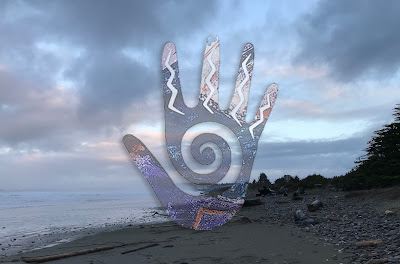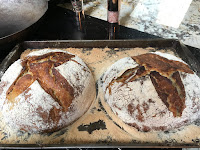 |
| Jedediah National Forest |
Muyye Weyya,
Many blessings! As I write this blog, it is during the final days of summer. We at our northwestern California coastal front are enjoying most lovely weather. Not the usual scenario. The winds pick up during these times and the weather is cold. This year I did not have enough energy and stamina to work our traditional Indigenous garden area by hand, where we plant our winter squash, beans and corn. It was a long winter with much rain, more than our share from last year. Hence, our season has been late. So I guess I can understand our later summer. However, there have been no winds and this year I did not plant any of my favorite mammoth sun flowers. One problem I have with them is I have to stake them deeply in the earth because our strong coastal winds will blow them down. (Our sunflowers get to be 11 feet or more tall). This year no winds and no sunflowers, whom I truly miss. Regardless, I paid heed to installing more flowers for our visiting pollinators, and they were very happy this year. Many hummingbirds, moths, butterflies, dragonflies, birds and bees came to visit, and they not only like the flowers but the pond as well. Despite the damp climate we have here, nature loves water features and water in general.
Each year the seasons are mysterious, and I suppose that is the intrigue of the garden. I continue to learn from the land every time. Some plants relatives that are supposed to grow here don't want to show up. Our tobacco that I planted last year, didn't want to visit, but this year decided out of the blue to show up unannounced amongst our broccoli and brussels sprouts. Gardening for me, is like having children, you can't expect anything but accept them. Some of them may be amazing producers and then others have to be quite coaxed along. I had planted 3 zucchini plants. One is an over producer that almost took over the entire bed, another was first to give up babies but petered out early, (though I told her she was doing great and still so welcomed to be in my garden). She still brings forth a youngster now and then. And then there is a tiny little thing that the flowers seem to over protect it. It doesn't seem to want to have babies and that's OK by me. I am just so glad it showed up.
And as I grow along with the land here, I realize I must change to adapt to it. Therefore, I am preparing myself for next spring's gardening in all the garden areas with a tiller. It has been many years I refused to bring machinery onto the land but if I am to sustain my life with a continued relationship with the land, I also must change when I need to. We have only cultivated 1/3 of the area that we live on the land so that we do not drive away any original neighbors. We reserve a small patch of living area that we gate so that Auggie (our family Doxie) has domain and the intruding Racoons and Bear, Coyote or Cougar actually have kept us at bay since he's claimed his yard. Oh, they come and visit, but there is no intrusion in comparison to when we first arrived. Thanks to Auggie. We are so grateful to him. All our fur family members are so valuable.
I think back on the early settlers who came to California and changed the landscape from grasslands to grazing lands for cattle. Such a change brought the demise to our natural wetlands, where so many waterfowl made homes and immense indigenous eco systems thrived. This change continued by developing and industrial colonists, bringing their designs and homeland invasive plants and animals into the natural indigenous habitat. They did not intend to live amongst but to colonist the region. To make it theirs and to change the region to what they are used to. The earth loses her stamina from the support of her many environmental relatives that the flooding/drought, and climactic changes that our society knows quite well now, has become prominent every season in California.
I apologize for the history lesson. I am just in reflection as the season prompts me. According to the Elders who share teachings of the Medicine Wheel, autumn (omchu walli), from my matriarchal Tamalko language, speak of the maturation time. It is the time when the human being learns to transition into an adult. For most of us, it's hard to let go of the summer. Many of us have memories of going on vacations and visiting family and/or relatives we hadn't seen. I remember summer at home in northern California, and spending time with relatives going to Bodega Bay starting with early morning sea weed gathering and cooking our breakfast and meals for the day on the beach. We all made great memories together. My immediate family also took our summer vacations visiting my father's relatives who live in San Diego. It was fabulous, going to the beaches there, fishing at night for grunions, visiting the San Diego zoo, and after-dinner story telling by my uncle and great uncle. And of course, playing with my cousins that we hadn't seen for the entire year.
But, when the crest of fall emerges, all the fun ends, and it's back to school, work and schedules. At least that was the perspective of a child.
However, from an adult, the vision is to come home again, to embrace the inner family once more. I see it as an acknowledgement of all the blessings we have in our lives, from our own children and homes to the relationships that support and sustain us on all levels of valued existence. Here in our inner circle, we take the time, as many say, to "batten down the hatches" to make or reestablish our secure foundations.
The autumnal season allows us to reflect on what we have and what is important to use for the caring and sustenance of our lives and for those we love. So I guess we get a little more serious about things. As the Elders remind us that fall is the adult season. We grow up and take responsibility for our lives and those who need our care. I always think about the autumnal season as a reclamation of who we are and making right again our walk upon the earth. It is a time when we are more conscious of our actions and words. When we have a deliberate consciousness of ways of being within our inner circle, we are then matured enough to follow suit outside among the rest of our relatives.
We at LUTEA begin our Medicine Wheel Wellbriety workshop during the fall season. I am always ready for the reflective work during the fall. Internally I am really ready, but everything else doesn't respond as quickly but it follows eventually. It usually takes about a month for us all to get to know eachother and to get familiar with indigenous practices and methods. By then we are immersed into the autumnal season and very aware of our internal journey and thus have the strength and courage to walk upon the Red Road towards further growth and wisdom.
I believe we have the opportunity and are intuitively susceptible as creatures of the earth to be most aware of learning at this reflexive season. The Earth continues to process life this season, even though the flowers slowly die, and the fruit of the vine have been harvested, leaving the debris to decompose. The smells of the process arise from the earth and they prompt us to be aware once again to new experiences. Stark contrasts of darkening days, are the backdrops to vibrant hues of reds, golds, and coppery burnt oranges amid various shades of green and intermingling purples and reds. It is a rich world of a deeper awareness that those that have a mind and heart to appreciate the chance to touch a journey towards wisdom will understand.
Imaging the richness of colors and earthy smells of the dampening lands reminds me of my favorite vegetable, the American indigenous winter squash. Yes, I miss their presence in my garden this year, but I am grateful that I can still find pumpkins in our local farmers market. So many autumnal foods honor our pumpkin relative from soups, pastas, appetizers, (i.e. pumpkin sage gnocchi and pumpkin ravioli that I love), and so many desserts and treats. My favorite that I continue to make through the years is a pumpkin bread. This bread is so moist and flavorful. When I enjoy it with a favorite cup of tea, I am reminded of the warmth of home. I am sharing my recipe with you in hopes you will make it sometime this season.
PUMPKIN BREAD
2 cups of pumpkin (canned or fresh cooked) I usually roast mine
1 cup of melted salted butter
3/4 cup of water
4 eggs
3 2/3 cups of flour
2 1/4 cups sugar
1 1/2 teaspoon of salt
1 teaspoon of nutmeg
2 teaspoons of cinnamon
2 teaspoons of baking powder
1 cup of raisins (I use golden raisins reminding me of the sun)
1 cup of chopped nuts (walnuts or pecans)
Blend the pumpkin, butter, water, and eggs until mixed. Add the flour, sugar, salt nutmeg, cinnamon, and baking soda. Then add the raisins and nuts. Pour your mixture into a greased and floured loaf pan. Bake at 350 degrees F for 1 hour or until golden brown. At times, I push a toothpick in the center just to make sure it's not sticky.
Enjoy with your favorite cup of tea.
If you ever attend our monthly meditation session, we can share a cup of tea/coffee and take time to sample something from my kitchen, perhaps even my pumpkin bread.
Perhaps it is still too early, but when the nip of fall comes to us, let the blessings of tea time be in our lives more often. Having tea was such an enjoyable pastime I wholeheartedly took part in the British Isles. Tea time was often and whenever one had a moment to pause in the day. Pauses are valuable in life. Like a pause when a musician plays music, there is a slight lift from the movement and then a return to the flow of the piece. (peace?) Such pauses are never intended to break us away from life but to give a moment to look into it in a reposed setting. I like to think that's what the birds do when they drop into our pond and flitter so slightly in the water, refreshing their moment. For they come back several times in an afternoon. Who says we can't take as many breaks as we need?
So, my friends, as we head back into the flow of the haven/home/foundation of our relational world, let's please feel quite grand that we are moving into that realm of responsible choices. Perhaps after we re account all that we have to work with as we journey into autumn, we may think a bit more cautiously. However, we are blessed, blessed to be here as human-beings able to live in our homeland of the Great Beautiful Mother Earth. And, yes, we will make some serious decisions now and again, but we are also learning to care for our wellness in a good (lovely/pleasant) way. As we continue this way of living a good life, we can come together and share warm moments of love and gratitude with eachother and a good cup of tea.
Hinaak Towis Hennak Weyya
Diveena




